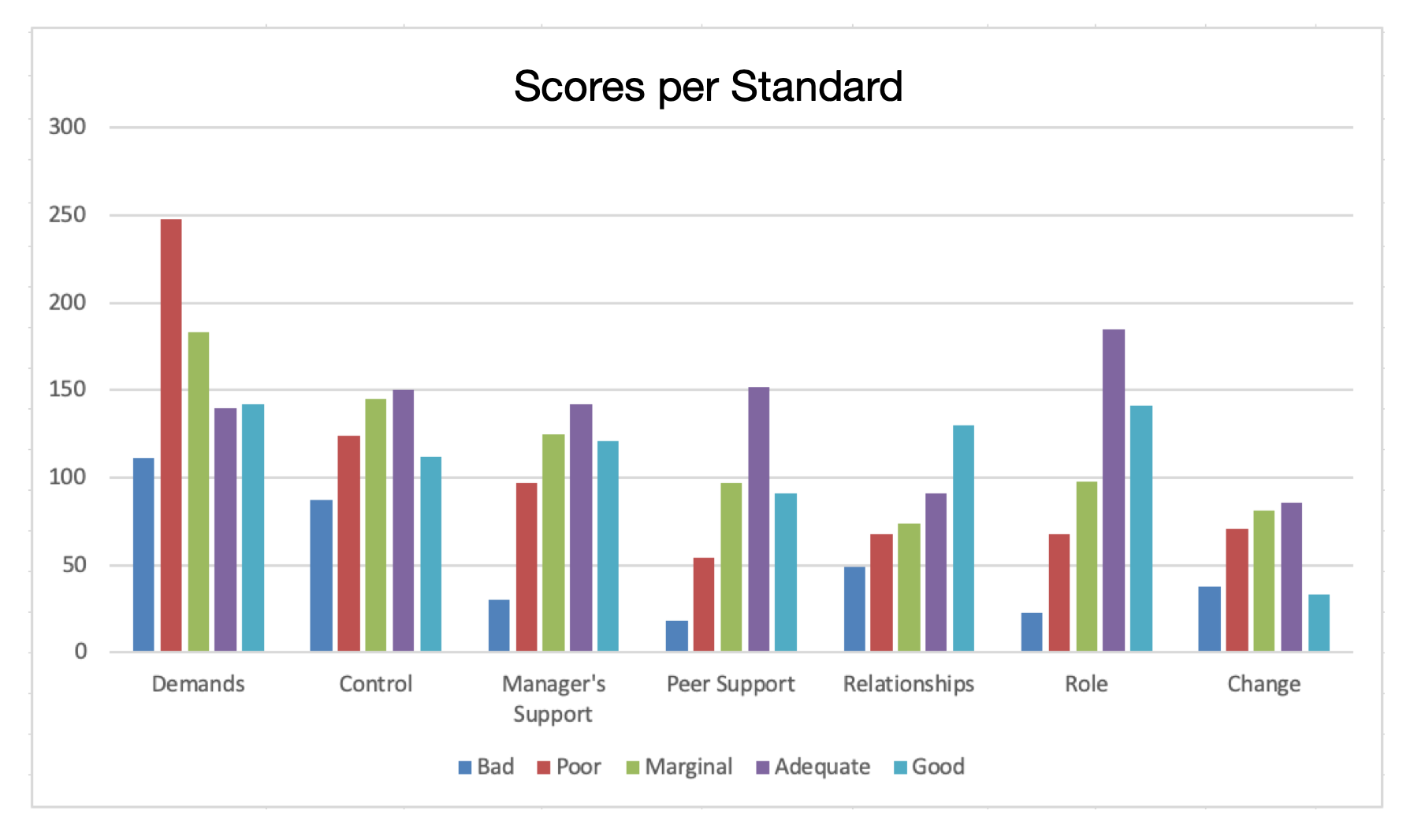One of several papers on management
And the results are in: managers aren’t helping manage employee stress
Written by John Berry on 26th March 2020. Revised 11th November 2020.
5 min read
The Health & Safety Executive (HSE) has developed a Management Standards Framework that allows managers and employees to assess how they are coping with the pressures of work. Using the HSE framework, TimelessTime developed a tool that managers can use to assess stress in themselves and their employees.
Managers have been using this tool online for a couple of years now, and here we present an analysis of this use.
The data has been collated from 103 manager responses, based on how they believe their employees feel about their stress-related well-being. The tool asks 35 questions which collect data on the six Management Standards.
We have had no influence over the respondents. All respondents are anonymous. We regard the responses as genuine. We consider therefore that all data is useful in this analysis.
Descriptive statistics
We give a description of data collection using the questionnaire and how descriptive statistics can be collated in our blog entitled Practical Use of the HSE Management Standards Indicator Tool.
There are six ‘standards’ which, when present and reinforcing, will moderate the relationship between the strain of the job and the stress felt by the employee. An example might be a highly pressured accident and emergency department staff in which staff cope. They perhaps have high levels of control over the work, strong manager support, good peer support, excellent relationships and a very clear role. Those four standards moderate the relationship between strain and stress to enable coping. Conceivably, were those standards not present, high workload and resulting strain would translate to personal stress. The result would be associated psychological and physiological maladies in each employee.
Taking this example, we can define how we’d like the data to look – what standards we’d expect to see, and in what degree, to enable coping. We can define a standard to which all managers should aspire – with all standards reported as adequate or good.
Graphical results
Generally, our scores from our analysis shows that the situation with managers is unsatisfactory. The image adjacent descibes this graphically.

Let’s look at the output of the analysis below and take each Management Standard in turn.
• The score for Demands placed on employees is well below that desired. We would expect that most managers would place adequate or good demands on employees. Blue, red and green, as bad, poor and marginal, illustrate unacceptably high and conflicting demands. We conclude that 66% of managers place excessive, conflicting demands in their teams.
• The degree to which employees are allowed control over their work is unsatisfactory. The Control result shows that 57% of managers allow a state of poor control to exist in their workplaces.
• The degree to which managers support their employees is unsatisfactory. Managers do not adequately support their people. 49% of managers report Manager’s Support as bad, poor or marginal.
• There is little improvement when it comes to Peer Support. 41% of managers have a state where peers or co-workers do not adequately support one another.
• Surprisingly, relationships at work between employees is not as good as we would expect. Some 46% of managers have a situation where Relationships are bad, poor or marginal.
• But at least in clarity of role, there’s some good news. Under Role, only 23% of managers have a situation where employees do not adequately understand their role. Note that this result allows us confidence in validity of the rest.
• And finally, back to bad news. 61% of managers oversee a situation where their employees have a bad, poor or marginal level of incessant Change going on in their jobs.
The results are pretty poor. We expected all management environments to report adequate or good, assuming that those scores would enable coping.
We have been lenient here in our reporting. Adequate is not really good enough. If we demanded that all were good, Demands, Control, Manager’s Support, Peer Support, Relationships and Change are all unsatisfactory in typically 80% of workplaces. Only Role is perhaps tolerable at 45%.
So, what do we conclude?
We allowed 103 managers to use our online tool to record scores using the HSE Management Standards Framework. The data was freely given and we consider that respondents were likely genuine in their recorded opinions against each item.
We do have to be cautious in drawing sweeping conclusions though. It is possible that those who completed the questionnaires were managers who knew they had problems – conceivably someone who has a coping workforce is unlikely to be trawling the Web reading up on stress management.
If, however, the data is a true reflection of workplaces today, managers are just not managing – they are not taking action to control the six management standards that mitigate stress.
This result is disappointing, but it is in line with the general trend claimed by researchers – that stress in the workplace is on the increase. But it’s not the strain that’s increasing! It’s management that’s deteriorating to cause the increased stress.
And the only conclusion - managers really must improve. Managers really must get trained and act.
This blog focussed on our analysis of data collected on our website. We can collect this type of data for you and your organisation. Contact us if you’d like to discuss this.
[Footnote – unfortunately, many commentators claim that the solution is to reduce the workload in order to reduce strain. That will work, but it will degrade productivity. The real action needed is to improve management quality.]